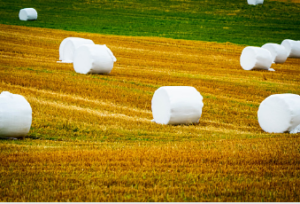Silage wrap is a crucial component in modern agriculture. It helps preserve crops for future consumption. It’s also used to protect animals from contamination and harmful bacteria.
There are two popular methods of wrapping silage bales – tube and single-bale. Each method has its pros and cons.
Osprey Silage Film
 Silage film is used to preserve bales of hay or maise, preventing over-fermentation and maintaining nutritional value. The film also helps to prevent the formation of harmful bacteria and fungus in the feed, which can damage the animals that consume it. The cling layer also ensures an airtight seal around the bale, which helps to keep moisture and oxygen out.
Silage film is used to preserve bales of hay or maise, preventing over-fermentation and maintaining nutritional value. The film also helps to prevent the formation of harmful bacteria and fungus in the feed, which can damage the animals that consume it. The cling layer also ensures an airtight seal around the bale, which helps to keep moisture and oxygen out.
When choosing a silage wrap, choosing one with high tensile strength and tear resistance is essential. It will protect the bale from external weather conditions and other factors that may cause damage, including abrasion. Choosing a wrap that stretches well to be easily applied to the bales is also essential.
Bales of hay are a staple in many farming operations, especially during winter when animals need more food than usual. Silage wraps are an excellent way to preserve grass and make it easier to store for long periods. They can help minimise degradation and improve the quality of the feed, resulting in healthier cattle.
A good silage film will have a high tensile strength, tear resistance, and cling level. It will also be easy to apply and offer an airtight seal. It will also be able to withstand heavy loads and extreme temperatures. Additionally, a good quality film will have UV stabilisation to protect it from the sun.
A silage wrap AU should be made from cast film to achieve the best results. It is more durable and has a higher cling level than blown films. It should also have a good dart impact and stretchability.
For a good quality silage film, look for one with a cling level of 5-10 N/m. It should also have a slip layer to prevent the movie from getting damaged during the stapling process. The cling level of the film is an essential part of its performance, as it is the key to an excellent airtight seal and prevents spoilage.
Powerstretch Silage Film
Powerstretch Silage Film is a highly versatile stretch wrap film that combines excellent stretching properties with the best resistance and durability to withstand different weather conditions. This film is made of high-quality materials and has been tested to ensure that it can hold up against extreme weather conditions, from freezing winter temperatures to the hot summer sun. This film can protect hay and other agricultural products from contamination, making it an ideal choice for farmers who want to protect their products from the elements.
The new film also provides an oxygen barrier to help preserve nutrients and prevent undesirable fermentation processes. Its opacity limits heating from sunlight and retards spoilage. The film is also easy to work with and can be cut to the desired size with a cutter. It makes it easier to wrap round hay bales and allows for more accurate wrapping.
Unlike conventional plastic films, stretch nylon is very resistant to tearing and damage. It has a low permeability for long-term storage of all agricultural products. Its thickness is also lower than conventional films, which reduces the risk of puncturing and tearing during transportation. In addition, it is easy to transport and can be used with any packaging machine.
This type of packaging can be used to wrap both round and square bales. It is also suitable for wet slurry or dung. The film can also keep moisture and insects out of the fodder. It is a cost-effective way to preserve the nutrients and quality of the hay or grain forage while protecting it from rain and wind.
In addition to its oxygen barrier, the film has a good cling level and can be used with any bale wrapper. The film is also available in a version that does not contain PIB, which reduces handling costs. PIB-free cast silage wrap AU film is more durable than conventional blown films and can wrap any bale shape.